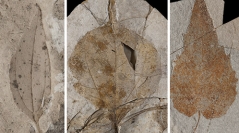

 Geodiversitas
42 (11) - Pages 151-174
Geodiversitas
42 (11) - Pages 151-174A major climatic shift, from a glasshouse world to a colder climate with well-developed ice sheets, occurred during the Cenozoic. Such a transition is recorded in both marine and terrestrial records. The latter is more fragmentary and thus comparatively less well known from a climatic point of view. Leaves are abundant fossil remains, which can be used as terrestrial climatic proxies. In this study, several historical collections from France and Belgium were re-investigated. We applied the Climate Leaf Analysis Multivariate Program in order to document the regional past climate from middle Paleocene to middle Miocene in Western Europe. Our analysis suggest relatively cooler conditions during middle Paleocene, followed by a gradual increase of mean annual temperature and precipitation seasonality during late Paleocene; increased temperature seasonality rather than a global cooling at the Eocene-Oligocene transition; an increase of temperature between early and late Oligocene and warm temperate climate in Western Europe similar to other parts of Europe during middle Miocene. These results are broadly consistent with the global trends observed through the Cenozoic era in the marine record. This study provides new quantitative paleoclimatic estimates for various key periods of the Cenozoic era in Western Europe. The consistency of our results with previous studies based on multiples proxies is in favor of the use of historical collections to reconstruct past climates, as long as sufficient sampling is provided.
Fossil leaves, paleoclimate, Cenozoic, CLAMP, terrestrial environment